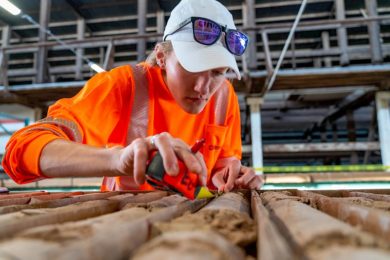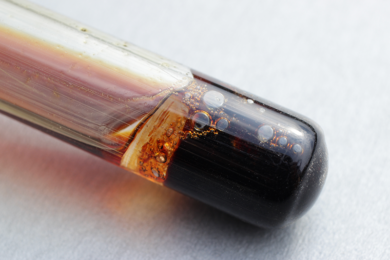Ivanhoe Electric has published the results of an Initial Assessment (IA) carried out on its Santa Cruz copper project, in Arizona, USA, highlighting the potential to build a 5.9 Mt/y underground mining operation that uses an all-electric underground heavy mining fleet, in combination with Railveyor technology for material movement.
The use of an all-electric underground heavy equipment fleet alone represents an estimated 70-80% reduction in Scope 1 emissions when compared to a traditional high-efficiency diesel-powered heavy equipment fleet, Ivanhoe says, adding thatthe use of Railveyor technology would further the efficiencies associated with moving mined mineralisation from underground to surface.
The IA base case assumes 70% of the total electric power requirements for the project will be generated by on-site renewable infrastructure, enabling copper production with very low carbon dioxide equivalent (CO2e) emissions of 0.49 t of CO2e per tonne of copper for Scope 1 and 2 emissions. This compares favourably with a global mining industry average of approximately 3.9 t of CO2e per tonne of copper equivalent, Ivanhoe says. The subsequent prefeasibility study for the project will evaluate the potential use of combined solar power, battery storage and a geothermal-driven microgrid as renewable power sources to provide up to 100% of the electricity requirements for the project.
The Santa Cruz IA outlines a potential 5.9 Mt/y underground mining operation, supported by 105.2 Mt of modelled mill feed with an average grade of 1.58% Cu from the Santa Cruz and East Ridge Deposits, resulting in an estimated 20-year mine life.
The IA focuses exclusively on the high-grade exotic, oxide and enriched domains of the Santa Cruz and East Ridge Deposits, with the oxide and enriched domains of the Texaco deposit not included in the current study (2.7 Mt indicated grading 1.42% total copper and 27.3 Mt inferred grading 1.39% total copper, using a 0.80% cut-off grade).
Future studies could evaluate the potential addition of the large primary sulphide domains at Santa Cruz (76.2 Mt indicated grading 0.88% total copper and 8 Mt inferred grading 0.92% total copper, using a 0.70% cut-off grade) and at the Texaco Deposit (900,000 t indicated grading 1.05% total copper and 35 Mt inferred grading 1.06% total copper, using a 0.80% cut-off grade), subject to market conditions.
Copper recoveries of 95.4% are expected to be achieved through a combination of solvent extraction and electrowinning and conventional froth flotation. The IA includes life of mine production for the project of 1 Mt of copper in the form of 99.99% pure copper cathode and 600,000 t of copper contained in a 48% copper concentrate with very low deleterious elements, such as arsenic or lead.
The IA contemplates initial project capital expenditures of $1.15 billion, and life of mine sustaining capital expenditures totaling $0.98 billion. A three-year construction period is envisioned to develop the underground workings and build the surface processing facilities.
As a result of the small surface footprint required for underground copper mining activities included in the IA, the total land area expected to be required for the mine, plant, tailings storage facilities and potential on-site generation of renewable solar power covers approximately one-third of the total land package.
The IA also contemplates placing 50% of the mine tailings back underground as cemented paste fill. The remaining 50% will be stored on the surface as thickened tailings at 65% solid content. Surface tailings will be contained within a ring dyke dam with a capacity to store 56.7 Mt. Water management associated with tailings storage is minimised as a result of thickened tailings and high evaporation rates in the Sonoran Desert, the company says.
Executive Chairman, Robert Friedland, said: “Completing the Initial Assessment for our Santa Cruz copper project is an important achievement for Ivanhoe Electric as we work to advance a new source of responsibly produced ‘green’ copper in the United States. Our goal is to develop a modern copper mine that produces copper with among the lowest levels of carbon dioxide output in the industry; a product we think has the potential to attract a premium price in the future.
“Using primarily on-site renewable electricity generation, and with the potential to increase that to meet the project’s entire future needs, the IA shows us that we are on the right track to achieving our goal at Santa Cruz and our larger goal of enhancing US supply chain independence for critical metals. We are excited about the future for our Santa Cruz project in Arizona.”
In the IA, twin declines, each measuring 4.3 km, would be developed to access the upper parts of the Santa Cruz and East Ridge deposits. One decline is required for air intake and access, while the other will be required for air exhaust and material movement. To develop the declines, the IA assumes that construction of the portal box cut would begin in 2026, decline development in 2027 and continues through 2028 to access the top portion of the mine. Under these assumptions, stoping activities would begin in 2029 with a one-year ramp up to the full 15,000 t/d capacity.
Mining of the upper portion would proceed for the first eight years before additional capital expenditures are required to extend the declines by 1.9 km. Additional surface infrastructure would be required once mining of the lower portion commences. This would include the second phase construction of a refrigeration plant, ventilation, water handling and material handling.
Mine sequencing would employ typical transverse longhole stopes for the Santa Cruz deposit on a primary-secondary sequence with paste backfill for support. Mining of the Santa Cruz exotic mineralisation has been evaluated using a drift and fill technique with access from the Santa Cruz longhole stoping levels. The East Ridge deposit will apply a drift and fill mining technique with access directly from the twin declines.
Over the total life of mine, 105.2 Mt of mineralised material is expected to be mined. This includes 88.6 Mt from the Santa Cruz deposit, 1.9 Mt from the Santa Cruz exotic mineralisation, 9.8 Mt from the East Ridge deposit and 4.9 Mt of low-grade material required to access the deposits.










